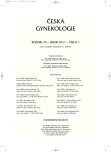Substitution of prenatal karyotyping with targeted QFPCR – cytogenetic residual risk assessment
Authors:
P. Čapková
; V. Curtisová; I. Dhaifalah; J. Hyjánek; J. Křepská; R. Streitová; J. Šantavý
Authors‘ workplace:
Ústav lékařské genetiky a fetální medicíny FN Olomouc a LF UP Olomouc, přednosta prof. MUDr. J. Šantavý, CSc.
Published in:
Ceska Gynekol 2011; 76(1): 51-55
Overview
Objective:
Molecular techniques focused on detection of common aneuploidies – FISH and QFPCR – provide a quick result in prenatal diagnosis. There is a trend to apply these rapid tests as ’stand-alone’ tests which would lead to substantial economical savings. The purpose of the retrospective study is to determine the frequency of chromosomal aberrations (CA) which would be missed by this tool in particular indication groups – residual cytogenetic risk.
Design:
Retrospective study.
Setting:
Department of Medical Genetics and Foetal Medicine University Hospital Olomouc.
Method:
5305 prenatal samples were examined and the frequency of QFPCR undetected CA (structural and rare aneuploidies) was observed.
Results:
The residual risk in patients referred for abnormal results of current prenatal screening programs for Down syndrome or for maternal age, without any ultrasound (US) pathological findings, was 0.9%. It was 6.9% in the group where US pathological findings or family history of CA were present.
Conclusion:
The rapid test can replace karyotyping if there is a risk for CA based exclusively on abnormal results of current screening programes for Down syndrome or age related risk, providing that US is normal.
Key words:
chromosomal aberration, prenatal cytogenetic diagnosis, quantitative fluorescent PCR (QFPCR), fluorescent in situ hybridisation (FISH).
Sources
1. Caine, A., Maltby, AE., Parkin, CA., et al. Prenatal detection of Down’s syndrome by rapid aneuploidy testing for chromosomes 13, 18, 21 by FISH or PCR without a full karyotype: cytogenetic risk assessment. Lancet, 2005, 366, p. 123-128.
2. Crolla, JA. To quit or not to quit prenatal cytogenetic diagnosis? Chrom Res, 2007, 15, p. 7–8.
3. Evans, MI., Henry, GP., Miller, WA. International, collaborative assessment of 146,000 prenatal karyotypes: expected limitations if only chromosome specific probes and fluorescent in situ hybridization are used. Hum Reprod, 1999, 14(5), p. 1213-1216.
4. Gregor, V., Šípek, A., Šípek, A. jr., Horáček, J., a kol. Prenatální diagnostika chromozomálních aberací Česká republika: 1994 – 2007. Čes Gynek, 2009, 74(1), s. 44-54.
5. Grimshaw, GM., Szczepura, A., Hulten, M., et al. Evaluation of molecular tests for prenatal diagnosis of chromosome abnormalities. Health Technol Assess, 2003, 7, p. 1-146.
6. Haddow, JE., Palomaki, GE., Knight, GJ., et al. Prenatal screening for Down’s syndrome with use of maternal serum markers. N Engl Med, 1992, 327, p. 588-593.
7. Hecht, CA., Hook, EB. The imprecision in rates of Down syndrome by 1- year maternal age intervals: a critical analysis of rates used in biochemical screening. Prenat Diagn, 1994, 14, p. 729-738.
8. Homer, J., Bhatt, S., Juany, S., Thangavelu, M. Residual risk for cytogenetic abnormalities after prenatal diagnosis by interphase fluorescence in situ hybridization (FISH). Prenat Diagn, 2003, 23, p. 566-571.
9. Hultén, MA., Dhanjal, S., Pert, B. Rapid and simple prenatal diagnosis of common chromosome disorders: advantages and disadvantages of the molecular methods FISH and QF-PCR. Reprod, 2003, 126, p. 279-297.
10. Jacobs, PA., Browne, C., Gregson, N., et al. Estimates of the frequency of chromosome abnormalities detectable in unselected newborns using moderate levels of banding. J Med Genet, 1992, 29(2), p. 103-108.
11. Kalousek, DK., Howard-Peebles, PN., Olson, SB., et al. Confirmation of CVS mosaicism in term placentae mosaicism, Prenat Diagn, 1991, 11, p. 743-750.
12. Leung, WC., Lau, ET., Lao, TT., Tang, MH. Can amnio-polymerase chain reaction alone replace conventional cytogenetic study for women with positive biochemical screening for fetal Down syndrome? Obstet Gynecol, 2003, 101, p. 856-861.
13. Lewin, P., Kleinfinger, P., Bazin, A., et al. Defining the efficiency of fluorescence in situ hybridization on uncultured amniocytes on retrospective cohort of 27 407 prenatal diagnoses. Prenat Diagn, 2000, 20, p. 1-6.
14. Mann, K., Donaghue, C., Fox, SP., et al. Strategies for the rapid prenatal diagnosis of chromosome aneuploidy. Eur J Hum Genet, 2004, 12(11), p. 907-915.
15. Nicolaides, KH., Azar, G., Byrne, D., et al. Fetal nuchal translucency: ultasound screening for chromosomal defects in first trimester of pregnancy. BMJ, 1992, 304, p. 867-869.
16. Nicolaides, KH. Nuchal translucency and other first-trimester sonographic markers of chromosomal abnormalities. Am J Obstet Gynaecol, 2004, 191(1), p. 45-67.
17. Spenser, K., Spenser, CE., Power, M., et al. Screening for chromosomal abnormalities in the first trimester using ultrasound and maternal serum biochemistry in a one stop clinic. A review of three years prospective experience. Br J Obstet Gynaecol, 2003, 110, p. 281-286.
18. Wald, NJ, Kennard, A., Hackshaw, A., McGuire, A. Antenatal screening for Down’s syndrome. J Med Screen, 1997, 7, p. 181‑246.
Labels
Paediatric gynaecology Gynaecology and obstetrics Reproduction medicineArticle was published in
Czech Gynaecology

2011 Issue 1
Most read in this issue
- Use of psychoactive substances and risk sexual behavior
- Fatal course of neonatal citrobacter infection and its legal evaluation
- Female sexual desire disorders – prevalence, classification and treatment possibilities
- Innate immunity in pathogenesis of intraamniotic inflammation in pregnancies complicated by preterm premature rupture of membranes
